
When defining a benefit, one or more benefit formulae must be linked to a benefit event and to a benefit membership group. This combination forms a benefit package.
Although the calculation of a benefit is usually a simple action, benefits may also be subject to other criteria. In such cases, benefits could be defined as being:
- a combination of one or more benefits
- subject to a minimum or maximum of another benefit / amount
- a benefit minus another benefit / amount
- the greater or lesser of another benefit / amount
- a combination of the above
Note:
Not all combinations are currently provided. See Using formulae and operands below.
To enable the calculation of these benefits by the system, the appropriate formulae must be captured on the system.
Refer to Define the benefit packages linked to each event above to get to the BADR Package List screen. Highlight the relevant PURPOSE on the BADR Package List screen, then select Benefit Product/Package from the sub-menu on the left.

The BAGC Package / Benefit Product Allocation screen will be displayed.
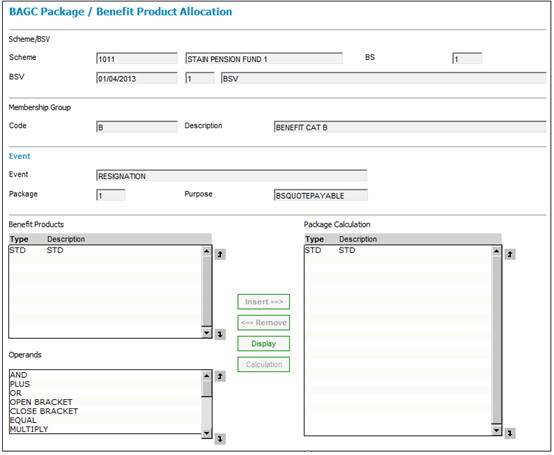
Function buttons on the BAGC Package / Benefit Product Allocation screen.
|
INSERT |
The Benefit Products and Operands panes on the left display all items that are available for selection. Highlight the required item and click INSERT to move it to the Package Calculation pane on the right. Continue to make these selections until the calculation has been completed. |
|
REMOVE |
To remove an item from the Package Calculation pane on the right, highlight the required item and click REMOVE. |
|
DISPLAY |
Displays the data defined in the Package Calculation pane in a single line.
Click DISPLAY. The BAGC Benefit Calculation screen will be displayed.
|
|
CALCULATION |
|
When the BAGC Package / Benefit Product Allocation screen is displayed, a MEMBERSHIP GROUP has already been selected,

and the EVENT, PACKAGE and PURPOSE have already been selected.

For these selections, use the selections available in the BENEFIT PRODUCTS drop-down box,

and theOPERANDS drop-down box,

to define the specific formula to be used for the EVENT.
Construct a formula as follows:
Select a value from either the BENEFIT PRODUCTS or OPERANDS drop-down box, then click INSERT. The selected value will be displayed in the Package Calculation pane on the right. Continue to make these selections until the formula has been completed for the event.
Example
A death benefit is defined as being a refund of contributions with interest plus the greater of the GLA cover or the refund scheme credit.
This benefit can be coded as follows:
|
Selection |
Value |
Action |
|
OPERAND |
GREATER OF |
INSERT |
|
OPERAND |
OPEN BRACKET |
INSERT |
|
BENEFIT PRODUCT |
GLA |
INSERT |
|
OPERAND |
OR |
INSERT |
|
BENEFIT PRODUCT |
STD |
INSERT |
|
OPERAND |
CLOSE BRACKET |
INSERT |
|
OPERAND |
PLUS |
INSERT |
|
BENEFIT PRODUCT |
REF |
INSERT |
The Package Calculation pane will now display the benefit products and operand functions selected:
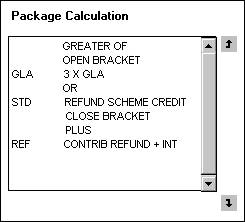
To view the formula defined, click DISPLAY. The BAGC Benefit Calculation screen will be displayed.
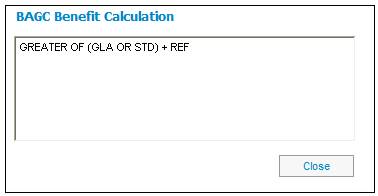
Click CLOSE to exit the Benefit Calculation screen.
To remove selections from the Package Calculation pane, highlight the relevant function, then click REMOVE.
Click Close Benefit Product /Package to the BADR Package List screen.
In mathematics, BODMAS (BRACKETS-OF-DIVISION-MULTIPLICATION-ADDITION-SUBTRACTION) defines the order of operations in a calculation.
Example:
1 + 2 * 3 ^ 2 + 1 would be evaluated as:
1 + (2 * (3^2) ) + 1
= 1 + (2 * 9 ) + 1
= 1 + 18 + 1 = 20.
The system does not currently follow the conventional laws of mathematics. Instead it follows a "left to right" law, and would evaluate the above formula as:
1 + 2 = 3
3 * 3 = 9
9 ^ 2 = 81
81 + 1 = 82
Note:
The conventional order can be forced by the use of brackets.
Note:
Refer to the BADS Package / Scheme Membership Group Allocation screen.
Each formula consists of a combination of the following:
- An indication of the purpose for which the formula will be used. This will always be the first value in the formula. The following values are available:
|
BS |
The benefit that will appear only on a benefit statement |
|
BSQUOTEPAYABLE |
The benefit that will be paid, and which will appear on a quote and a benefit statement |
|
INSURED |
The benefit that is insured |
|
PAYABLE |
The benefit that will be paid to the member |
|
QUOTE |
The benefit that will appear only on a quote |
|
VALUATION |
The benefit that will appear only on a valuation report |
- The benefit product code and description.
- One of the following operands:
- AND
- CLOSE BRACKET
- DIVIDE
- EQUAL
- MULTIPLY
- GREATER OF
- GREATER THAN
- GREATER THAN EQ
- IF
- LESS THAN EQ
- LESSER OF
- MAXIMUM
- MAXIMUM ZERO
- MINIMUM
- MINIMUM ZERO
- MINUS
- OPEN BRACKET
- OR
- PLUS
Because of the large number of possible combinations of PAYABLE, INSURED, QUOTE and BS, only the most common combination has been provided for BSQUOTEPAYABLE. This means that even if the benefit payable to the member and the insured benefit are the same, a package will need to be set up for each, one where the purpose is BSQUOTEPAYABLE or PAYABLE, and one where the purpose is INSURED.
Refer to the BADS Package / Scheme Membership Group Allocation screen for more information on the PURPOSE field.
The following is a list of the only formula structures that have been provided for in combination with any of the purposes (INSURED, PAYABLE, etc.).
Note:
For the sake of clarity, brackets have been used in place of the words OPEN BRACKET and CLOSE BRACKET.
- BENEFIT PRODUCT 1
- BENEFIT PRODUCT 1 PLUS BENEFIT PRODUCT 2
- BENEFIT PRODUCT 1 MINUS BENEFIT PRODUCT 2
- GREATER OF (BENEFIT PRODUCT 1 OR BENEFIT PRODUCT 2)
- LESSER OF (BENEFIT PRODUCT 1 OR BENEFIT PRODUCT 2)
- GREATER OF (BENEFIT PRODUCT 1 OR BENEFIT PRODUCT 2) MINIMUM BENEFIT PRODUCT 3
- (BENEFIT PRODUCT 1 PLUS BENEFIT PRODUCT 2) PLUS GREATER OF (BENEFIT PRODUCT 3 OR BENEFIT PRODUCT 4)
- (BENEFIT PRODUCT 1 PLUS BENEFIT PRODUCT 2) PLUS LESSER OF (BENEFIT PRODUCT 3 OR BENEFIT PRODUCT 4)
- (BENEFIT PRODUCT 1 PLUS BENEFIT PRODUCT 2) PLUS LESSER OF (BENEFIT PRODUCT 3 OR BENEFIT PRODUCT 4) MINIMUM BENEFIT PRODUCT 5
- BENEFIT PRODUCT 1 PLUS GREATER OF (BENEFIT PRODUCT 2 OR BENEFIT PRODUCT 3)
- GREATER OF (BENEFIT PRODUCT 1 OR BENEFIT PRODUCT 2) PLUS BENEFIT PRODUCT 3
- GREATER OF ((BENEFIT PRODUCT 1 PLUS BENEFIT PRODUCT 2) OR BENEFIT PRODUCT 2)(BENEFIT PRODUCT 1 MINUS BENEFIT PRODUCT 2) MINIMUM ZERO
The formula structures listed above are currently subject to the limitation whereby if either FAS or REF is the designated benefit product, then it can be the only benefit product in the resultant formula structure. For example:
- GREATER OF (FAS OR STD) is a valid formula
- GLA PLUS GREATER OF (FAS OR STD) is not a valid formula
Note:
Only one OR is allowed in a GREATER OF statement, e.g. the following is not allowed:
GREATER OF (ABC OR KLM OR XYZ), etc.
However, you can you have a nested GREATER OF, e.g.
GREATER OF (GREATER OF (ABC OR KLM) OR XYZ)
Abolition of Office
For the Benefit Event of Abolition of Office, the system will allow the MAXIMUM operand to be used in conjunction with FAS Products, viz. FAS1 MAXIMUM FAS2, which means that the FAS1 result is used providing that it is less than or equal to the FAS2 result.
If FAS1 is greater than FAS2, the FAS2 results will be used going forward in the claim process.
From the BACJ BSV MAINTAIN screen, click APPROVE.
If there are still outstanding items to be defined, the BACJ BSV Consistency Report screen will be displayed.
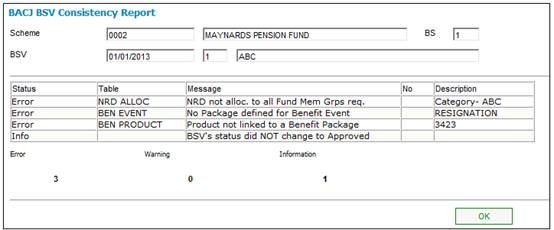
This screen displays the errors generated, and the specific reasons.
Click OK to close the screen. Complete the outstanding items listed, then from the BSV Maintain screen, click APPROVE again.
If all of the mandatory items have been input, the JU1DB Scheme Benefit Structure Version Maintain screen will be displayed.
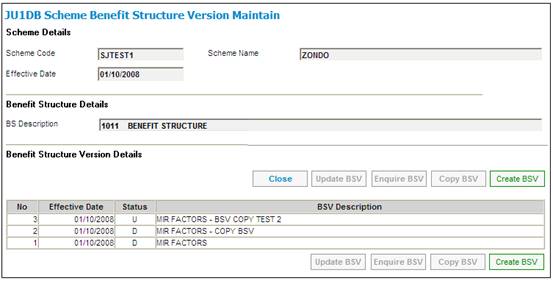
The status of the BSV will change to A and CREATE BSV will be enabled, allowing the addition of a new BSV.
This completes the defining of the benefit structures. You will not be able to close the benefit rules section of the product update list if this step has not been carried out.
From the JU1BH Product Update Type List screen, click CLOSE UPDATE to close this update type.
Instead of adding NRA, Benefit Product and Benefit Event details manually, you can make a copy of an existing BSV, which may have similar details to those required for the new BSV. It should be noted, however, that you can only make a copy of the BSV of the product in which you are working. i.e. you cannot copy the BSV from another product.
Note:
To make a copy of the BSV of another scheme, use the scheme copy facility. Refer to
Product Launch Requirements
Associations
Copy
Once the details have been copied, you can edit them using UPDATE BSV.
On the JU1DB Scheme Benefit Structure Version Maintain screen, highlight the new (unapproved) BSV and click COPY BSV.
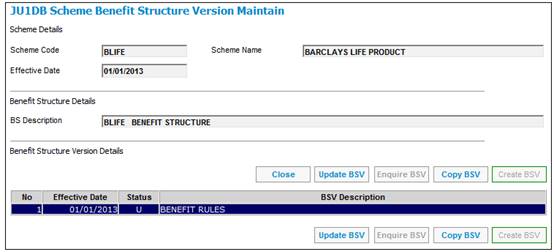
The BSV Copy screen will be displayed.
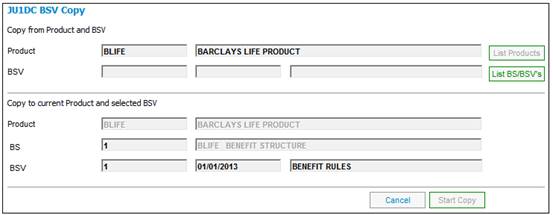
If this product is a sub-scheme of a main product, LIST SCHEMES will be enabled.
Refer to
Product Launch Requirements
Associations
Click LIST SCHEMES to view a list of sub- products also associated with the same main product.
Highlight the required benefit structure version and click SELECT. The system returns to the JU1DC BSV Copy screen, which now displays the selections made.
Click LIST BS/BSVs. The BACL Benefit Structure List screen will be displayed.

This screen displays all benefit structures available for selection. Highlight the required benefit structure, then select BSV List from the sub-menu on the left.
The BACK Benefit Structure Version List screen will be displayed.
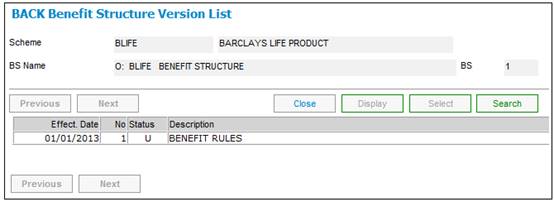
This screen displays all benefit structure versions available for selection. Highlight the required benefit structure version and click SELECT. The system returns to the JU1DC BSV Copy screen, which now displays the selections made.
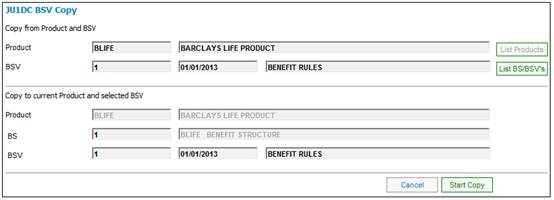
Click START COPY. The system will confirm that the copy was successful.
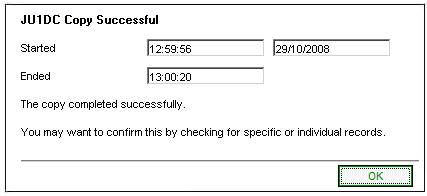
Click OK to remove the message screen.
To check or make changes to the BSV details copied, highlight the BSV on the JU1DB Scheme Benefit Structure Version Maintain screen and click UPDATE BSV.
Note:
Even if the copy is successful, the benefit packages are not copied, and need to be re-linked using the Benefit Event>Benefit Package option.
Once you are satisfied with the contents of the BSV, click APPROVE from the BACJBSV Maintain screen.